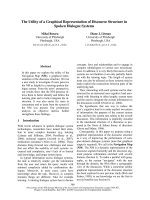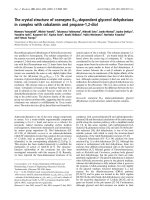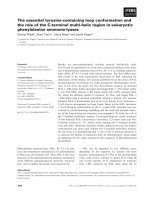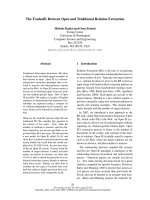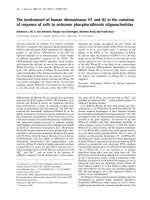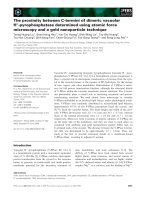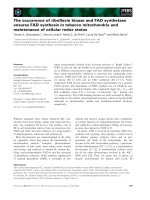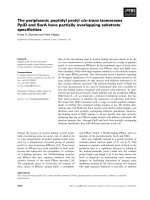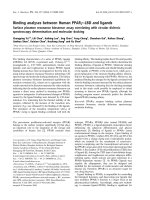báo cáo khoa học: " The relationship between self-reported substance use and psychiatric symptoms in low-threshold methadone maintenance treatment clients" docx
Bạn đang xem bản rút gọn của tài liệu. Xem và tải ngay bản đầy đủ của tài liệu tại đây (283.75 KB, 10 trang )
RESEARCH Open Access
The relationship between self-reported substance
use and psychiatric symptoms in low-threshold
methadone maintenance treatment clients
Heather G Fulton
1
, Sean P Barrett
1,2*
, Cindy MacIsaac
3
and Sherry H Stewart
2,1
Abstract
Background: Ongoing psychiatric symptoms and substance use are common difficulties experienced by clients
enrolled in methadone maintenance treatment (MMT). However, little research to date has evaluated if specific
types of current substance use are related to specific types of current psychiatric symptoms. The present study
investigated these relationships with a sample of clients enrolled in a low-threshold MMT program (i.e., clients are
not expelled if they continue to use substances). Some clients enrolled in low-threshold programs may never
achieve complete abstinence from all substances. Thus, understanding the possibly perpetuating relationships
between concurrent substance use and psychiatric symptoms is important. Understanding such relationships may
aid in developing possible target areas of treatment to reduce substance use and/or related harms in this
population.
Methods: Seventy-seven individuals were interviewed regard ing methadone usage and current and past substance
use. Current psychiatric symptoms were assessed using a modified version of the Psychiatric Diagnostic Screening
Questionnaire (PDSQ). Relationships between types of substances used in the past 30 days and the types and
number of psychiatric symptoms experienced in the same timeframe were examined.
Results: The majority of participants (87.0%) reported using alcohol, illicit substances, non-prescribed
prescription opioids, or non-prescribed benzodiazepines in the past 30 days and 77.9% of participants reported
currently experiencing psychiatric symptoms at levels that would likely warrant diagnosis. Current non-
prescribed benzodiazepine use was a predictor for increased severity (i.e., symptom count) of almost all anxiety
and mood disorders assessed. Conversely, number and presence of generalized anxiety symptoms and
presence of social phobia symptoms predicted current non-prescribed benz odiazepine and a lcohol use,
respectively.
Conclusions: Individuals enrolled in the present low-threshold MMT program experience a wide variety of
psychiatric symptoms and continue to use a variety of substances, including opioids. There was a particularly
consistent pattern of associations between non-prescribed benzodiazepine use and a variety of psychiatric
symptoms (particularly anxiety) suggesting that addressing concurrent illicit benzodiazepine use and anxiety
symptoms in MMT clients warrants further clinical attention and research.
Keywords: methadone, psychiatric symptoms, psychopathology, low-threshold, substance use, benzodiazepine
* Correspondence:
1
Department of Psychology, Dalhousie University, Halifax, Nova Scotia,
Canada
Full list of author information is available at the end of the article
Fulton et al . Harm Reduction Journal 2011, 8:18
/>© 2011 Fulton et al; licensee BioMed Central Ltd. This is an Open Access article distributed under the terms of the Creative Commons
Attribution License ( which perm its unrestricted use, distribution, and reproductio n in
any medium, provided the original work is properly cited.
Background
Individuals enrolled in Methadone Maintenance Treat-
ment (MMT) progr ams often continue to misuse sub-
stances [1,2]. Continued use of substances while in
MMT is a predictor of poorer MMT treatment outcome
[e.g., [3,4]], and represents an ongoing challenge to
treatment providers [1,5]. Another important factor
related to MMT success is clients’ mental health [6,7].
While figures greatly vary, it has been estimated that
between 28-76% of MMT clients have at least one co-
morbid psychiatric disorder [8-10]. Current psychiatric
co-morbidity in MMT clients is associated with poorer
psychosocial [11] and medical [12] status as well as
decreased quality of life [13]. Similarly, psychiatric dis-
tress/severity is generally predictive of poorer MMT
outcome [1] although this finding has not always been
consistent [10,14]. Current psychiatric symptoms also
appear to be associated with ongoing substance use and
substance-related problems during MMT. Individuals in
MMT with a co-morbid psychiatri c disorder have a sig-
nificantly greater number of lifetime substance use dis-
orders [15], more severe substance use problems [11],
and use more substances during MMT [10,16].
While some studies have examined relations between
psychiatric symptoms and substance use by MMT cli-
ents, most research has focused on presence/absence of
any psychiatric co-morbidity (i.e., presence/absence of
any psychiatric disorder, not presence/absence of specific
psychiatric disorders), general level of psychiatric dis-
tress/severity, or only a limited number of disorders (e.
g., depression only). Little research has focused on how
different types of psychiatric symptoms may vary by
types of substances used. Theory [e.g. [17]] and previous
research in non-MMT substance-using samples suggest
that specific forms of co-morbidity may be associated
with use of specific substances. For example, individuals
who fear anxiety-related sensations are more likely to
use anxiolytics and to suffer f rom anxiety-related disor-
ders. Conversely, individuals who tend to act impulsively
are mor e likely to use substances such as cocaine and to
suffer psychiatric symptoms in the impulsive domain
[18].
The relationships of specific types of se lf-reported,
current substance use to specific types of current psy-
chiatric symptoms were examined in the present study.
While evaluating concurr ent substance use and psychia-
tric symptoms in the present study does not per mit an
analysis of which disorder came first (i.e., a determina-
tion of temporality as it may relate to causality), the pre-
sent evaluation is important to understanding possible
perpetuating factors that may maintain both substance
use and psychiatric distress in MMT clients. For exam-
ple, if illicit benzodiazepine use is associated with only
one type of psychiatric symptoms (e.g., panic symptoms
but not depression), tailoring interventions specific to
helping clients cope with panic symptoms could poten-
tially assist in re ducing benzodiazepine use a nd asso-
ciated overdose risks [19,20]. Further, evaluating
concurrent substance use and psychiatric symptom rela-
tionships in low-threshold MMT programs (i.e. , clients
are not expelled if they continue to use substances) is of
particular importance given some clients in these pro-
grams may never achieve complete abstinence from all
substances. Whether clients’ psychiatric symptoms are
the pathogenic result of substance use or r eflect an
independent p sychiatric disorder may be relat ively
unimportant if the substance use never ceases. Instead,
reducing harms associated with their use (e.g., overdose
risk), including reducing distress (e.g., through decreas-
ing anxiety), are important and relevant treatment goals.
In the present study, individuals enrolled in a low-
threshold MMT program, who were predominantly
receiving treatment for prescription opioid misuse,
underwent confidential face-to-face interviews as part of
a larger study examining substance use behaviours. It
was predicted that current types of substance use would
be related to current types of psychiatric symptoms.
Specifically it was predicted that anxiety-related symp-
toms (e.g., symptoms of Generalized Anxiety Disorder
[GAD], Post-Traumatic Stress Disorder [PTSD]) would
be related to current anxiolytic (e.g., benzodiazepines,
alcohol) use. Similarly, it was predicted that impulsive-
type psychiatric symptoms (e. g., symptoms related to
binge eating) would be related to current stimulant use
(e.g., cocaine).
Methods
Participants
Seventy-seven participants recruited from a low-thresh-
old MMT program in Halifax, Nova Scotia, Canada took
part in the present study. In comparison to more tradi-
tional, or “ high-threshold”, MMT clin ics, “low-threshold”
clinics do not require clients to be abstinent from all sub-
stances in order to remain in treatment [21]. Instead a
harm-reduction approach is taken whereby clients obtain
privileges, such as the ability to receive their methadone
at a community pharmacy, for remaining abstinent from
substances. The target populat ion of the clinic are injec-
tion drug users who have significant comorbid mental
health issues, are dependent on a variety substances, are
HIV-, Hepatitis B- and/or C-infected, are homeless and/
or street-involved, and/or have been unsuccessful in
higher-threshold or abstinence-based treatment pro-
grams. All clients enrolled in the MMT program were
eligible to participate; there were no exclusion criteria.
Demographic data are displayed in Table 1.
Fulton et al . Harm Reduction Journal 2011, 8:18
/>Page 2 of 10
Measures
All m easures were administered verbally to particip ants
so that no participant was excluded due to low literacy.
Using a semi-structured interview, participants were
interviewed regarding demographics, methadone treat-
ment (see Table 1), and c urrent and lifetime substance
use [22]. For 19 different substances (see Table 2), parti-
cipants were asked whether they ever used the sub-
stance, age of first use, and number of days in the past
30 they used the substance. Participants were also asked
whether t hey used medications from the classes of pre-
scription opioids (excluding methadone) and benzodia-
zepin es with and without a prescription in their lifetime
and in the previous 30 days. Participants who had used
any benzodiazepines or prescription opioids without a
prescription in the past 30 days were defined as “any
non-prescribed users” . Participants who had only used
benzo diazepines or presc ription opioids with a prescrip-
tion were defined as “only prescribed users”.
For the last 21 participants tested, the above substance
use questions were administered a second time by a dif-
ferent interviewer the following day to determine relia-
bility. Substantial reliability for presence of past 30 day
use was obtained (Cohen’s s = 0.82-1.00; 95.0-100.0%
agreement).
To assess current psychiatric symptoms, a modified
Psychiatric Diagnostic Screening Questionnaire (PDSQ
[23]) was used. This measure contained 125 ye s/no
questions regarding experiencing symptoms of 13 DSM-
IV [24] Axis I disorders in the past two weeks or past
30 days (past two weeks and past six months are used
in the original version). This modification enab led the
period of reported psychiatr ic symptoms to be within
the substance use interview’s assessment of use in the
preceding 30 days. An individual screened positive for a
disorder on the PDSQ if s/he endorsed the predeter-
mined minimal number of symptoms for that diagnostic
category (see Table 3). Screening positive for a disorder
on the PDSQ suggests that an individual would be sig-
nificantly more likely to qualify for a diagnosis of that
disorder than someone who did not screen positive [23].
In previous studies the PDSQ has been found to have
good sensitivity (90% of cases screening positive war-
ranted a diagnosis), negative predictive values (97% of
cases that did not screen positive did not warrant a
diagnosis), reliable and valid (see [23] for review) - even
in a sample of individuals with substance use disorders
[25].
The modified and original versions of the PDSQ were
administered to the last 21 participants in the present
study by separate in terviewers one day apart. Good
reliability between the two versions in terms of the
number of symptoms endorsed and number of positive
screens of disorders was found (rs = .87,.81,
respectively).
Questions relating to drug and alcohol dependence
were excluded from analysis given the pre sent study’ s
objective of evaluating the relationship between sub-
stance use and symptoms of psychiatric disorders other
than substance use disorders.
Table 1 Demographic information reported by sample participants (n = 77)
Characteristic %(n) of Sample or [M{SD}]
Age Years [39.66{8.79}]
Gender Male 62.3 (48)
Female 37.7 (29)
Psychiatric Medication Prescribed antidepressant (e.g., citalopram) 33.8 (26)
Prescribed antipsychotic (e.g., quetiapine) 22.1 (17)
Prescribed any psychiatric medication 63.6 (49)
Education Less than high school/equivalent 50.6 (39)
Completed high school/equivalent 49.4 (38)
Ethnicity Caucasian 80.5 (62)
Non-Caucasian/multiple ethnicities 19.5 (15)
Income $10 000 or less per year 67.5 (52)
More than $10 000 per year 32.5 (25)
Living Status Renting 87.0 (67)
Community Shelter 10.4 (8)
Other 2.6 (2)
Current MMT program use Years enrolled in current program prior to study interview [3.00]
1
Daily methadone dose (mg) [112.04{43.97}]
Days/past 30 methadone used [28.36{4.48}]
Proportion enrolled in previous MMT programs 46.8 (36)
1
Median is reported due to the large standard deviation for this variable: M(SD) = 3.40(3.05)
Fulton et al . Harm Reduction Journal 2011, 8:18
/>Page 3 of 10
Table 2 Substance use by sample participants (n = 77) attending a low-threshold MMT program
Drug % (n) Sample
Ever Used
Mean Age (SD) of First Use
for Lifetime Users
%(n) Sample Using in
Preceding 30 days
Of Lifetime Users, Number of Days of Use
in Preceding 30 Days M(SD)
Tobacco 100.0 (77) 11.5(4.0) 97.4 (75) 29.68(1.95)
Alcohol 98.7 (76) 13.0(4.5) 21.1 (16) 1.72(5.23)
Crack Cocaine 93.5 (72) 26.1(9.1) 44.2 (34) 4.92(9.39)
Powder Cocaine 89.6 (69) 19.2(5.8) 9.1 (7) 0.59(3.65)
Amphetamine/
Methamphetamine
57.1 (44) 20.4(7.0) 0 (0) 0(0)
MDMA
1
66.2 (51) 26.5(9.9) 3.9 (3) 0.12(0.52)
Cannabis 94.8 (73) 13.2(3.4) 48.1 (37) 6.47(10.70)
LSD
2
84.4 (65) 16.2(3.7) 1.3 (1) 0.14(1.13)
Psilocybin 71.4 (55) 17.0(4.4) 0 (0) 0(0)
Mescaline 59.7 (46) 19.1(4.7) 0 (0) 0(0)
Peyote 14.3 (11) 18.5(2.8) 0 (0) 0(0)
Salvia 14.3 (11) 32.2(11.3) 1.3 (1) 0.90(0.30)
GHB
3
9.1 (7) 20.4(6.3) 0 (0) 0(0)
Peyote 14.3 (11) 18.5(2.8) 0 (0) 0(0)
PCP
4
44.2 (34) 20.8(7.4) 1.3 (1) 0.47(2.65)
Ketamine 23.4 (18) 26.1(7.3) 2.6 (2) 1.06(4.24)
Inhalants 40.3 (31) 16.6(7.0) 1.3 (1) 0.32(0.18)
Opium 22.1 (17) 22.4(6.7) 0 (0) 0(0)
Heroin 49.4 (38) 24.3(6.1) 0 (0) 0(0)
Only Prescribed
Prescription Opioids
88.3(68) –
5
9.1(7) –
Any Non-prescribed
Prescription Opioids
98.7 (76) – 24.7 (19) –
Only Prescribed
Benzodiazepines
76.6 (59) – 20.8 (16) –
Any Non-prescribed
Benzodiazepines
89.6 (69) – 40.3 (31) –
1
3,4-Methylenedioxymethamphetamine
2
Lysergic acid diethylamide
3
Gamma-hydroxybutyrate
4
Phencyclidine
5
Data for the general categories of Only Prescription Opioids, Any Non-Prescribed Prescription Opioids, Only Prescribed Benzodiazepines and Any Non-Prescribed
Benzodiazepines were not collected for age of ever use and number days of use/past 30.
Table 3 Psychiatric symptoms of sample (n = 77) as assessed by the PDSQ
Disorder (# of symptoms assessed on PDSQ; # of symptoms
required for a positive screen)
Mean(SD) number of symptoms
endorsed by sample
% Sample Screening Positive
for Disorder(n)
Eating Disorder (10;7) 1.64 (2.55) 7.8 (6)
Psychosis (6;1) 0.68 (1.24) 32.5 (25)
Hypochondriasis (5;1) 0.75 (1.31) 33.8 (26)
Somatization Disorder (5;1) 1.36 (1.38) 42.9 (33)
Depression (21;9) 6.45 (5.20) 31.2 (24)
Post Traumatic Stress Disorder ([PTSD] 15;5) 5.78 (5.26) 48.1 (37)
Obsessive Compulsive Disorder ([OCD] 7;1) 1.58 (2.10) 49.4 (38)
Panic Disorder (8;4) 2.05 (2.49) 27.3 (21)
Agoraphobia (12;4) 2.08 (2.83) 24.7 (19)
Social Phobia (15;4) 2.65 (3.80) 29.9 (23)
Generalized Anxiety Disorder ([GAD] 10;7) 3.81 (3.77) 28.6 (22)
Total number of symptoms endorsed (114) 28.83 (24.00)
Fulton et al . Harm Reduction Journal 2011, 8:18
/>Page 4 of 10
Procedure
All clients enrolled in the MMT program were informed
of their eligibility to participate in the present study. Cli-
ents were informed that all study information would be
kept confidential, participation (or lack thereof) would
not affect their treatment, and participation was volun-
tary. All interviews were conducted by personnel sepa-
rate from clinic staff in a private room at the clinic.
Participants gave verbal and written informed consent
and were compensated $20 at the completion of the
study. All sampling, procedures, and materials were
reviewed and approved by t he Dalhousie and Capital
Health Research Ethics Boards.
Analyses
In order to ensure adequate variability for statistical
analyses, if at least 10% of the sample, but not m ore
than 90%, had used a substance in the past 30 days or
screened positive for a psychiatric disorder, the variable
was included in further analyses examini ng the relation-
ships between current substance use and psychiatric
symptoms. Dichotomous var iables were a nalyzed using
chi-square (c
2
) tests; two- sided Fisher’sexacttestswere
used whenever expected counts were less than 5 to
minimize chances of Type 1 error [26]. Continuous vari-
ables were analyzed using independent sample t-tests
and bivariate correlations.
Because substances are often used in a polysubstance
context [27], multiple regressions were conducted to
evaluate whether current use o f specific substance(s)
was(were) better predictor(s) of the number of psychia-
tric symptoms endorsed for each type of disorder
assessed by the PDSQ. Logistic regressions were also
conducted to evaluate whether current use of specific
substance(s) was(were) better predictor(s) of screening
positive on the PDSQ for different types of psyc hiatric
symptoms.
Because psychiatric symptoms also often co-occur
[28], and due to the possible bidirectional relationship
of psychiatric symptoms and substance use [29], logistic
regressions were conducted to evaluate if the number of
specific types of psychiatric symptoms were better pre-
dictors of the likelihood to be currently using different
substances. Additional logistic regressions were con-
ducted to evaluate whether screening positive for certain
types of psychiatric symptoms on the PDSQ would also
predict the likelihood of currently using different
substances.
Results
Substance use
The majority of participants (87.0%, n = 67/77) reported
using alcohol, illicit substances, non-prescribed prescrip -
tion opioids, and/or non-prescribed benzodia zepines at
least once in the past 30 days (see T able 2). Participants
used,onaverage,2.04(SD = 1.67) different substances,
excluding tobacco, in the past 30 days; or 3.01 (SD =
1.68) different substances if tobacco is included. Pre-
scription opioids and benzodiazepines were each
counted as one substance, regardless of whether the
type of medication was used with and/or without a pre-
scription. Participants reported that all current benzo-
diazepine and opioid prescriptions were from doctors
not affiliated with the present MMT program; prescrip-
tions were obtained from family or emergency room
doctors.
Psychiatric Symptoms
Sixty participants (77.9%, n = 60/77) screened positive
for at least one psychiatric disorder on the modified
PDSQ. Participants, on average, screened positive for
3.52(SD = 3.16) different psychiatric disorders (see
Table 3).
Because reporting o f psychiatric symptoms has been
found to decrease with time enroll ed in MMT in some
studies [29,30], relationships between psychiatric symp-
toms and current methadone treatment variables were
examined. T here were no significant differences in cur-
rent methadone dose or duration enrolled in the current
MMT program between those who did and did not
screen positive for any psychiatric disorders (ps > 0.05).
Current Substance Use and Psychiatric Symptoms
Results of the multiple regression analyses of current
substance use predicting the number of symptoms of
different types of psychiatric disorders are displayed in
Table 4. Non-prescribed benzodiazepine use significantly
pred icted the number of sym ptoms endors ed for almost
all moo d and anxiety symptoms assessed as well as the
total number of symptoms endorsed on the PD SQ.
Similar results were also obtained when logistic regres-
sions were run with current substance use predicting
the likelihood to screen positive on the PDSQ for differ-
ent disorders (see Table 5). Non-prescribed benzodiaze-
pine use significantly predicted the likelihood to screen
positive for depression, PTSD, GAD, social phobia, as
well as the likelihood to screen positive for at least one
disorder on the PDSQ (Any disorder assessed on the
PDSQ). Current alcohol use was also a significant uni-
variate predictor for likelihood to screen positive for
social phobia.
For the logistic regressions of psychiatric symptoms
predicting the likelihood to use different substances,
non-prescribed benzodiazepine use was significantly pre-
dicted by the num ber of different types of psychiatric
symptoms (c
2
(10) = 3 6.27, p < .001); number of GAD
symptoms was the only univariate predictor (p = .024,
OR = 1.48, 95%CI = 1.05-2.08). When screening positive
Fulton et al . Harm Reduction Journal 2011, 8:18
/>Page 5 of 10
for different psychiatric disorders were used as predic-
tors in the regression analyses instead of the number of
psychiatric sympto ms endorsed, current non-prescribed
benzodiazepine use was significantly predicted (c
2
(10) =
35.24, p < .001) by screening positive for GAD (p =
.033, OR = 17.52, 95%CI = 1.26-246.10) and agorapho-
bia (p = .040, OR = 0.07, 95%CI = 0.01-0.88). That is,
screening positive for GAD was associated with an
increased likelihood of currently using non-prescribed
benzodiazepines while screening positive for agorapho-
bia was associated with a decreased likelihood of cur-
rently using non-prescribed benzodiazepines. However,
the relationship of screening positive for agoraphobia
and past 30 day non-prescribed benzodiazepine use was
examined further for possible suppressor effects. There
was no significant correlation between screening positive
for a goraphobia and past 30 day non-prescribed benzo-
diazepine use (point biserial r =.13,p = .277) but
screening positive for GAD and agoraphobia were highly
correlated (point biserial r = .57, p < .001). Thus, it is
likely that the relationship between agoraphobia and
non-prescribed benzodiazepine use reflects a suppressor
effect [31]
a
. Lastly, past 30 day alcohol use was found to
be significantly predicted (c
2
(10) = 18.9 7, p = .0 41) by
Table 4 Multiple regressions of past 30 day substance-use predicting psychiatric symptoms
Dependent Variable (# of symptoms
endorsed on PDSQ)
Model F(6,67) = p Adjusted R
2
Significant predictors (p) Beta
Psychosis 1.44 .212 .04
Hypochondriasis 1.71 .133 .06
Somatization disorder 1.83 .107 .06
Depression 6.16 <.001 .27 -Any non-prescribed benzodiazepine use (<.001) .58
PTSD 3.60 .004 .18 -Any non-prescribed benzodiazepine use (<.001) .46
OCD 3.99 .002 .20 -Any non-prescribed benzodiazepine use (<.001) .44
Panic disorder 2.42 .035 .11 -Any non-prescribed benzodiazepine use (.001) .41
Agoraphobia 1.40 .226 .03
Social phobia 2.73 .020 .12 -Any non-prescribed benzodiazepine use (.004) .37
GAD 6.06 <.001 .29 -Any non-prescribed benzodiazepine use (<.001) .60
Total number of all symptoms assessed 3.08 .010 .15 -Any non-prescribed benzodiazepine use (<.001) .49
*Predictors entered in all regressions: Any non-prescribed benzodiazepine use, Only prescribed benzodiazepine use, Any non-prescribed prescription opioid use,
Any alcohol use, Any cannabis use, and Any crack use in the past 30 days.
**Significant univariate predictors are presented only in the case of a significant multivariate model.
Table 5 Logistic regressions of past 30 day substance use predicting screening positive for types of psychiatric
symptoms
Dependent Variable (screening positive for
disorder on PDSQ)
Model X
2
(p)
Significant predictors (p) Odds ratio
(OR)
95% confidence interval
for OR
Psychosis 8.01(.238)
Hypochondriasis 10.08(.121)
Somatization disorder 10.50(.105)
Depression 22.08(.001) -Any non-prescribed benzodiazepine
use (.001)
9.63 2.67-34.68
PTSD 22.40(.001) -Any non-prescribed benzodiazepine
use (.001)
7.56 2.26-25.31
OCD 11.91(.064)
Panic disorder 10.43(.108)
Agoraphobia 10.82(.091)
Social phobia 23.37(.001) -Any non-prescribed benzodiazepine
use (.003)
7.70 2.00-29.58
-Alcohol use (.018) 6.59 1.28-31.33
GAD 21.06(.002) -Any non-prescribed benzodiazepine
use (<.001)
12.30 3.17-47.72
Any disorder assessed on PDSQ 18.25(.006) -Any non-prescribed benzodiazepine
use (.006)
22.14 2.42-203.00
*Predictors entered in all regressions: Any non-prescribed benzodiazepine use, Only prescribed benzodiazepine use, Any non-prescribed prescription opioid use,
Any alcohol use, Any cannabis use, and Any crack use in the past 30 days.
**Significant univariate predictors are presented only in the case of a significant multivariate model.
Fulton et al . Harm Reduction Journal 2011, 8:18
/>Page 6 of 10
screening positive for social phobia (p = .025, OR =
15.28, 95%CI = 1.40-166.56).
Discussion
The present study found high rates of cu rrent use of a
variety of substances as reported by clients enrolled in a
low-threshold MMT program. Similar to previous stu-
dies of substance use by MMT clients [1,2], alcohol,
cannabis, coca ine, prescr iption opioi ds, and benzodiaze-
pines were commonly -used substances; c urrent use of
hallucinogens or inhalants was rare. Consistent with
previous research in higher-threshold MMT programs
(e.g., [9,10,12]), the present study also found high rates
of psychiatric symptom report ing by low-threshold
MMT clients. For many clients, these reports revealed
levels of psychiatric symptoms that may warrant clinical
diagnosis [23].
As expected, we found support for relations between
current substance use and current psychiatric symptom
reporting. In particular, current non-pr escribed benzo-
diazepine use predicted the number of psychiatric symp-
toms endorsed for m ost mood- and anxiety-related
psychiatric disorders as well as predicti ng the likelihood
of screening positive for most mood- and anxiety-related
disorders assessed on the PDSQ. That is, current non-
prescribed benzodiazepine use was associated with an
increased number of psychiatric symptoms, and was
associated with an increased likelihood of experiencing
different psychiatric symptoms at levels that may war-
rant diagnosis. Current alcohol use (in addition to non-
prescribed benzodiazepine use) was also found to be
associated with an increased likelihood to screen posi-
tive for social phobia (see Table 5).
Conversely, current psychiatric symptoms were found
to predict the likelihood of different typ es of current
substance use. Number of GAD symptoms, as well as
screening positive for this disorder on the PDSQ, made
a unique contribution in predicting current non-pre-
scribed benzodiazepine use. Screening positive for soc ial
phobia (but not the number of these types of symptoms)
was associated with an increased likelihood of current
alcohol use.
The findings that any current non-prescribed benzo-
diazepine use uniquely predicted number and the likeli-
hood of experiencing psychiatric symptoms-namely
anxiety and depression, and that GAD symptoms appear
to be a unique predictor among psychiatr ic symptoms
of current no n-prescribed benzodiazepine use, is consis-
tent with previous literature. While little re search has
indicated whether benzodiazepine use was prescribed or
non-prescribed, benzodiazepine users in MMT pro-
grams have been found to have higher levels of anxiety
symptoms [32,33], suicidal ideation, more suicide
attempts [34] and low er psychosocial functioning [33]
than non-users.
It is possible that non-prescribed benzodiazepines are
being used to self medicate distressing psychiatric symp-
toms such as generalized anxiety symptoms [17]. It is
also possible anxiety-related withdrawal symptoms from
benzodiazepines may be causing or exacerbating any
existing anxi ety symptoms [19,35-37]. Alternativel y,
these individuals could have a common underlying vul-
nerability to both benzodiazepine use and psychiatric
symptoms [30,38]. Regardless of the basis for the rela-
tionship, these findings, in combination with existing lit-
erature [32,33], suggest that non-prescribed
benzodiazepine use may be indicative of higher levels of
psychopathology and related problems in MMT clients.
Multiple systemic barriers often prevent individuals with
concurrent psychiatric and substance use issues from
accessing appropriate treatment (e.g., organization of
services, finances [39]). Thus, further investigations and
treatment development in this area are likely to be
fruitful.
Of note is the finding that screening positive for agor-
aphobia was a significant predictor of decreased likeli-
hood to use non -prescribed benzodiazepines and this
relationship was likely indicative of a suppressor ef fect
[31]. In this case, while screening positive for GAD may
capture much of the variance in predicting non-pre-
scribed benzodiazepine use, it is likely that screening
positive for agoraphobia improves prediction of non-
prescribed benzodiazepine use (despite the lack of an
independent relationship with between these two vari-
ables) by accounting for avoidance related to anxiety.
That is, agoraphobia may be protective of non-pre-
scribed benzodiazepine use because individuals who
often avoid anxiety-inducing situations may not feel
they need to use benzodiazepines to manage their anxi-
ety. They may be able to avoid anxiety through avoiding
certain situations, whereas people with GAD symptoms
may avoid anxiety through non-prescribed benzodiaze-
pine use. Further investigations are needed to determine
if this hypothesis is correct.
The finding that social phobia and alcohol use were
related is also consistent with previous literature. Many
studies have found high rates of comorbidity between
social anxiety and alcohol problems [see [40] for review].
Alcohol use while enrolled in MMT is also associated
with increased overdose risk [20]. Thus, programming
to address this assoc iation could also b e beneficial to
decreasing mortality and other harms.
Thereareanumberoflimitationstothepresent
study. First, the present study consisted of a relatively
small sample. Thus, there could be concerns regarding
reliability of t he findings. However, Type II error, not
Fulton et al . Harm Reduction Journal 2011, 8:18
/>Page 7 of 10
Type I, is more likely with small sample sizes, and the
present sample size exceeds the 5:1 (participants: predic-
tor variable) regression guidelines, as well as those sug-
gested by Miles and Shevlin (2 001) [26]. Second, the
PDSQ is weighted for emphasis on anxiety disorders.
Although it assesses eating disorder symptoms, the
PDSQ does not assess other disorders that theoretically
woul d be related to stimulant use rather than benzodia-
zepine use (e.g., ADHD). More complex relationships
between types of current psychiatric symptoms and
types of current substance use may be revealed with
more comprehensive psychiatric assessments. Third, the
PDSQ does not assess Axis II [24] symptomatology. Per-
sonality disorders, particularly antisocial and borderline,
have been found to be highly prevalent in opioid-depen-
dent individuals (see [34] for review; prevalences can
vary between 15-73% for presence of any personality
disorder compared to 10% in the general population).
Opioid-dependent individuals with such disorders have
been found to have increased severity of depression,
anxiety and substance use problems (e.g., alcohol depen-
dence) [41]. Further investigations into the extent to
which such personality pathology may be accounting for
the observed psychiatric symptoms and substance use
relationships are warranted. Fourth, it is possible that
the positive screens on the PDSQ may be over inclusive
for some disorders regarding likelihood to receive a
diagnosis. It seems somewhat unlikely that almost 50%
of the sample would receive a legitimate diagnosis of
OCD or somatization diso rder if further assessed.
Instead, endorsing items such as repeated checking of
locks on doors may better reflect the sometimes
unstable and unsafe circumstances of participants’ ho us-
ing, and endorsement of somatization disorder symp-
toms such as “stomach and intestinal problems” may
reflect side effects of MMT. Despite these possibilities,
the rates of psychiatric symptoms reporting in the pre-
sent study were comparable to previous research with
methadone clients (e.g., [9,10,12]) and the PDSQ clearly
measured some level of specific psychiatric symptoma-
tology in the present study given the large effect sizes
and consistency of relationships with non-prescribed
benzodiazepine use. Another limitation of t he present
study was that substance use behavior was based on
self-report. While there are some crit icisms of thi s
method [42], it has been found to produce accurate
results, particularly under circumstances enhancing
accurate reporting like those used in the present study
[42,43]. Because of assurances of confidentiality, partici-
pation not influencing treatment, and compensation for
participation not being contingent upon reporting (or
not reporting) s ubstance use, there was no motivation
to minimize or exaggerate any substance use. Indeed,
when assessed, the test-retest reliability of the present
study measures was excellent.
The present research has a number of implications for
both further practice and research. In terms of practice,
it was somewhat surprising to have found a relatively
large (20.8%, n = 16/77) percentage of clients having
current prescriptions for benzodiazepines and/or opioids
from health professionals outside of the current MMT
program. It is possible some clients’ family or emer-
gency room doctors may not be aware their clients are
on methadone, and/or MMT programs may not be
aware a client is obtaining benzodiazepines or opioids
via other medical professionals. This suggests that access
to updated health records- for both MMT programs and
other physicians (e.g., through electronic health records)
could be beneficial given prescription drug monitoring
programs may not always flag occurrences such as those
in the present study. While prescribed benzodiazepine
use did not have the same associations as non-pre-
scribed use, there is still substantial overdose risk by
concurrently using benzodiazepines with methadone
[20,44]. In terms of research implications, given that
there is remaining uncertainty if individuals enrolled in
MMT may be using non-prescribed benzodiazepines to
manage distressing mood states (such as anxiety), or if
the reverse or another reason may be accounting for the
observed relationships, research examining longitudinal
patterns of substance use and psychiatric symptoms in
MMT clients, or specific occasions of use should be
conducted to further examine these competing hypoth-
eses . The present study findings also suggest that future
research and practice could focus on furt her developing,
tailo ring, and evaluating interven tions to address benzo-
diazepine use by MMT clients. Possible therapeutic tar-
gets could include tailored interventions focusing on
managing generalized anxiety symptoms and psychoedu-
cati on (e.g., [45]) regarding the biological and psycholo-
gical effects (both long- and short-ter m) of usi ng
benzodiazepines. It is possible such interventions could
help this population to reduce benzodiazepine use, its
related negative effects, as well as associated psychiatric
symptom severity. Similar tailored programming may
also be beneficial if focused on alcohol use and social
anxiety symptoms. Previous research suggests that
addressing both psychiatric symptoms and substance
use concurrently in treatment, in an integrated fashion,
islikelytobethemostfavorabletreatmentapproach
[46].
Conclusions
Low-threshold MMT clients report high rates of both
current substance use and current psychiatric symp-
toms. Non-prescribed benzodiazepine use appears to be
Fulton et al . Harm Reduction Journal 2011, 8:18
/>Page 8 of 10
a unique predictor of experiencing psychiatric symp-
toms- particularly various types of anxiety. Conversely,
GAD symptoms appear to be a unique predictor
amongst psychiatric symptoms in identifying current
non-prescribed benzodiazepine use. Further investiga-
tions regarding the temporal nature of benzodiazepine
use and psychiatric symptoms, as well as possible devel-
opment of interventions tailored specifically to addres-
sing this relationship, could be beneficial to our
understanding of psychopathology and substance use.
Further, additional research and clinical work in this
area may assist in reducing the serious risk of overdose
and harm posed by using subs tances, particularly benzo-
diazepines, while enrolled in MMT.
Endnotes
a
Briefly, a classic suppressor effect occurs when the
addition of a predictor to the regression results in
another predictor (or group of predictors) increasing in
predictive validity, even though the newly added predic-
tor may be unrelated to the dependent variable. See [31]
for further explanation.
List of abbreviations
CI: Confidence Interval; F: F ratio for overall regression model; GAD:
Generalized Anxiety Disorder; GHB: Gamma-hydroxybutyrate; LSD: Lysergic
acid diethylamide; M: Mean; MDMA: 3,4-Methylenedioxymethamphetamine;
MMT: Methadone Maintenance Treatment; n: Number of participants in
subsample; OCD: Obsessive Compulsive Disorder; OR: Odds Ratio; p:
Probability of Type 1 error; PCP: Phencyclidine; PDSQ: Psychiatric Diagnostic
Screening Questionnaire; PTSD: Post-Traumatic Stress Disorder; r: Correlation
coefficient; R
2
: Coefficient of determination; SD: Standard Deviation; χ
2
: Chi
square.
Acknowledgements
The authors would like to acknowledge those who assisted with the present
study: Jessica Meisner, Cathy Hilchey, Haley Gray, Desiree MacDonald, Sergiu
Mocanu, Lindsay Peters, Lyndsay Bozec, and Direction 180 staff and clientele.
The authors would also like to thank the funders of this study and the
authors’ work: a Canadian Institutes of Health Research grant to SPB & SHS, a
Canadian Institutes of Health Research Doctoral Research Award and
research stipend to HGF, a Killam Doctoral Scholarship to HGF, and a Killam
Research Professorship to SHS.
Author details
1
Department of Psychology, Dalhousie University, Halifax, Nova Scotia,
Canada.
2
Department of Psychiatry, Dalhousie University, Halifax, Nova Scotia,
Canada.
3
Direction 180, Halifax, Nova Scotia, Canada.
Authors’ contributions
All authors have contributed significantly to this research report and have
read and approved the final manuscript. HGF assisted with the planning of
the study, conducted data collection, contributed to data analysis,
interpretation, write-up and funding of the study. SPB and SHS assisted with
planning of the study, data analysis, interpretation of results, writing of the
manuscript and funding of the study. CM assisted with planning of the
study, data collection, practice implications, as well as reviewed and revised
the drafts of the manuscript.
Competing interests
The authors declare that they have no competing interests.
Received: 9 April 2011 Accepted: 28 July 2011 Published: 28 July 2011
References
1. Darke S: The effectiveness of methadone maintenance treatment 3:
Moderators of treatment outcome. In Methadone Maintenance Treatment
and Other Opioid Replacement Therapies. Edited by: Ward J, Mattick RP, Hall
W. Amsterdam, Netherlands: Harwood Academic Publishers; 1998:75-89.
2. Stitzer ML, Chutuape MA: Other substance use disorders in methadone
treatment. In Methadone Treatment for Opioid Dependence. Edited by: Strain
EC, Stitzer ML. Baltimore, Maryland: The John Hopkins University Press;
1999:86-117.
3. Magura S, Nwakeze PC, Demsky S: Pre- and in-treatment predictors of
retention in methadone treatment using survival analysis. Addiction 1998,
93:51-60.
4. Morral AR, Belding MA, Iguchi MY: Identifying methadone maintenance
clients at risk for poor treatment response: Pretreatment and early
progress indicators. Drug Alcohol Depend 1999, 55:25-33.
5. Kleber HD: Methadone maintenance 4 decades later: Thousands of lives
saved but still controversial. J Am Med Assoc 2008, 300:2303-2305.
6. McLellan AT, Luborsky L, Woody GE, et al: Predicting response to alcohol
and drug abuse treatments: Role of psychiatric severity. Arch Gen
Psychiatry 1983, 40:620-625.
7. McLellan AT, Childress AR, Griffith J, et al: The psychiatrically severe drug
abuse patient: Methadone maintenance or therapeutic community? Am
J Drug Alcohol Abuse 1984, 10:77-95.
8. Astals M, Diaz L, Domingo-Salvany A, et al: Impact of co-occurring
psychiatric disorders on retention in a methadone maintenance
program: An 18-month follow-up study. Int J Environ Res Public Health
2009, 6:2822-2832.
9. Callaly T, Trauer T, Munro L, et al: Prevalence of psychiatric disorders in a
methadone maintenance population. Aust N Z J Psychiat 2001, 35:601-605.
10. Gelkopf M, Weizman T, Melamed Y, et al: Does psychiatric comorbidity
affect drug abuse treatment outcome? A prospective assessment of
drug abuse, treatment tenure and infectious diseases in an Israeli
methadone maintenance clinic. Isr J Psychiatr Rel 2006, 43:126-136.
11. Brooner K, King VL, Kidorf M, et al: Psychiatric and substance use
comorbidity among treatment-seeking opioid abusers. Arch Gen Psychiat
1997, 54:71-80.
12. Cacciola JS, Alterman AI, Rutherford MJ, et al: The relationship of
psychiatric comorbidity to treatment outcomes in methadone
maintained patients. Drug Alcohol Depend
2001, 61:271-280.
13.
Carpentier PJ, Krabbe PF, van Gogh MT, et al: Psychiatric comorbidity
reduces quality of life in chronic methadone maintained patients. Am J
Addict 2009, 18:470-480.
14. Pani PP, Trogu E, Contu P, et al: Psychiatric severity and treatment
response in a comprehensive methadone maintenance treatment
program. Drug Alcohol Depend 1997, 48:119-126.
15. Strain EC, Brooner RK, Bigelow GE: Clustering of multiple substance use
and psychiatric diagnoses in opioid addicts. Drug Alcohol Depend 1991,
27:126-134.
16. Batki SL, Ferrando SJ, Manfredi L, et al: Psychiatric disorders, drug use and
medical status in injection drug users with HIV disease. Am J Addict 1996,
5:249-258.
17. Khantzian EJ: The self-medication hypothesis of addictive disorders:
Focus on heroin and cocaine dependence. Am J Psychiat 1985,
142:1259-1264.
18. Conrod PJ, Pihl RO, Stewart SH, et al: Validation of a system of classifying
female substance abusers on the basis of personality and motivational
risk factors for substance abuse. Psychol Addict Behav 2000, 14:243-256.
19. Longo LP, Johnson B: Addiction: Part 1. Benzodiazepines- Side effects,
abuse risk and alternatives. Am Fam Physician 2000, 61:2121-2128.
20. Wolff K: Characterization of methadone overdose: Clinical considerations
and the scientific evidence. Ther Drug Monit 2002, 24:457-470.
21. Royal College of Psychiatrists: Chapter 8. Treatment of Drug Misuse. Drugs:
Dilemmas and Choices Thornliebank, Glasgow, UK: Bell and Bain Limited;
2000, 147-184.
22. Gross SR, Barrett SP, Shetowsky JS, et al: Ecstasy and drug consumption
patterns: A Canadian rave population study. Can J Psychiat 2002,
47:546-551.
23. Zimmerman M: The Psychiatric Diagnostic Screening Questionnaire Los
Angeles, California: Western Psychological Services; 2002.
24. American Psychiatric Association: Diagnostic and statistical manual of mental
disorders. Fourth edition. Washington, DC; 1995, Author.
Fulton et al . Harm Reduction Journal 2011, 8:18
/>Page 9 of 10
25. Zimmerman M, Sheeran T, Chelminski I, et al: Screening for psychiatric
disorders in outpatients with DSM-IV substance use disorders. J Subst
Abuse Treat 2004, 26:181-188.
26. Field A: Discovering Statistics Using SPSS. Third edition. London, UK: Sage
Publications Limited; 2009.
27. Barrett SP, Darredeau C, Pihl RO: Patterns of simultaneous polysubstance
use in drug using university students. Hum Psychopharm Clin 2006,
21:255-263.
28. Brown TA, Barlow DH: Comorbidity among anxiety disorders: Implications
for treatment and DSM-IV. J Consult Clin Psych 1992, 60:835-844.
29. Conrod PJ, Stewart SH: Cognitive-behavioral treatments for comorbid
substance use and psychiatric disorders: Strengths, limitations and
future directions. J Cogn Psychother 2005, 19:261-284.
30. King VL, Brooner RK: Assessment and treatment of comorbid psychiatric
disorders. In Methadone Treatment for Opioid Dependence. Edited by: Strain
EC, Stitzer ML. Baltimore, Maryland: The John Hopkins University Press;
1999:141-165.
31. Tzelgov J, Henik A: Suppression situations in psychological research:
Definitions, implications, and applications. Psych Bull 1991, 109:524-536.
32. Brands B, Blake J, Marsh DC, et al: Impact of benzodiazepine use on
methadone maintenance treatment outcomes. J Addict Dis 2008,
27:37-48.
33. Darke S, Swift W, Hall W, et al: Drug-use, HIV risk-taking behavior and
psychosocial correlates of benzodiazepine use among methadone
maintenance clients. Drug Alcohol Depend 1993, 34:67-70.
34. Ward J, Mattick RP, Hall W: Psychiatric comorbidity among the opioid
dependent. In Methadone Maintenance Treatment and Other Opioid
Replacement Therapies. Edited by: Ward J, Mattick RP, Hall W. Amsterdam,
Netherlands: Harwood Academic Publishers; 1998:419-440.
35. Ciraulo DA, Ciraulo JA, Sands BF, Knapp CM, Sarid-Segal O: Sedative-
hypnotics. In Clinical Manual of Addiction Psychopharmacology. Edited by:
Kranzler HR, Ciraulo DA. Arlington, Vermont: American Psychiatric
Publishing; 2005:111-1s62.
36. Posternak MA, Mueller TI: Assessing the risks and benefits of
benzodiazepines for anxiety disorders in patients with a history of
substances abuse or dependence. Am J Addict 2001, 10:48-68.
37. Westra HA, Stewart SH: As-needed use of benzodiazepines in managing
clinical anxiety: Incidence and implications. Curr Pharm Des 2002, 8:59-74.
38. Martins SS, Keyes KM, Storr CL, et al:
Pathways between nonmedical
opioid use/dependence and psychiatric disorders: Results from the
national epidemiologic survey on alcohol and related conditions. Drug
Alcohol Depend 2009, 103:16-24.
39. Ridgely SM, Goldman HH, Willenbring M: Barriers to the care of persons
with dual diagnoses: Organizational and financial issues. Schizophr Bull
1990, 1:123-132.
40. Morris EP, Stewart SH, Ham LS: The relationship between social anxiety
disorder and alcohol use disorders: A critical review. Clin Psychol Rev
2005, 25:734-760.
41. Kosten TA, Kosten TR, Rounsaville BJ: Personality disorders in opiate
addicts show prognostic specificity. J Subst Abuse Treat 1989, 6:163-168.
42. Darke S: Self-report among injecting drug users: A review. Drug Alcohol
Depend 1998, 51:252-263.
43. Ward J, Mattick RP, Hall W: The use of urinalysis during opioid
replacement therapy. In Methadone Maintenance Treatment and Other
Opioid Replacement Therapies. Edited by: Ward J, Mattick RP, Hall W.
Amsterdam, Netherlands: Harwood Academic Publishers; 1998:239-264.
44. Caplehorn JR, Drummer OH: Fatal methadone toxicity: Signs and
circumstances, and the role of benzodiazepines. Aust N Z J Pub Heal
2002, 26:358-363.
45. Ahmed M, Westra HA, Stewart SH: A self-help handout for
benzodiazepine discontinuation using Cognitive Behavioral Therapy.
Cogn Behav Pract 2008, 15:317-324.
46. Stewart SH, O’Connor RM: Treating anxiety disorders in the context of
concurrent substance misuse. In Treatment Resistant Anxiety Disorders.
Edited by: Sookman D, Leahy R. New York, New York: Routledge;
2010:291-323.
doi:10.1186/1477-7517-8-18
Cite this article as: Fulton et al.: The relationship between self-reported
substance use and psychiatric symptoms in low-threshold methadone
maintenance treatment clients. Harm Reduction Journal 2011 8:18.
Submit your next manuscript to BioMed Central
and take full advantage of:
• Convenient online submission
• Thorough peer review
• No space constraints or color figure charges
• Immediate publication on acceptance
• Inclusion in PubMed, CAS, Scopus and Google Scholar
• Research which is freely available for redistribution
Submit your manuscript at
www.biomedcentral.com/submit
Fulton et al . Harm Reduction Journal 2011, 8:18
/>Page 10 of 10
